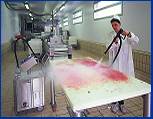
This work was necessary to determine the effectiveness of killing microbes in their own natural environment, in which they embed themselves within an adhesive, self generated slime (biofilm) in moist conditions, such as bath, taps, showers, tiles, grouting etc.
This protective biofilm can resist powerful chemical agents for prolonged periods, but the considering superheated steam transfers its heat energy totally into the slime, as it is composed of 97% water, and the heat kills the organism underneath. Up to 500,000 germs can be present on one square inch of washbasin, shower tile or grout. Typically 90% to 100% of germs were killed in the bathroom environment in a 30 second exposure of toilet rims, washbasins, shower tiles and grouting. The additional value of a powerful vacuum system is that it removes bacteria and dirt into a dust-free liquid container in the body of the machine, preventing aerosols which otherwise might put microbes back into the atmosphere. Further trials were then undertaken on mock hospital training wards and the main evaluations were carried out on working geriatric wards over a three month period. These conditions are the most challenging due to the frequent soiling of these areas and difficulty of working with minimal disruption, in busy working hospital wards and in patient sensitive areas.
Despite all the adverse conditions 80% to 90% microbial kill efficiency was achieved when measured 30 minutes after steam vacuum cleaning. Another innovative feature was also introduced during this study: the rapid monitoring of disinfection using bioluminescent swabs. Normally the only way cleanliness is assessed at this facility is visually, but even a clean surface can be coated in biological dirt (bacteria and human cells coated with bacteria). The swabs glow when in contact with living bacteria through the same chemical reaction that lights up the tails of fireflies. When disinfection takes place the light diminishes in proportion to kill and this can be read in a small light monitor in under a one minute. The process is easy to perform, unlike conventional microbiological cultures, which may take 48 hours incubation and require special growth media and skilled technologists to interpret. According to Jonathan Kite: “The advent of super-heated steam/vacuum systems mark a major advance in the constant fight against disease causing microbes.”


